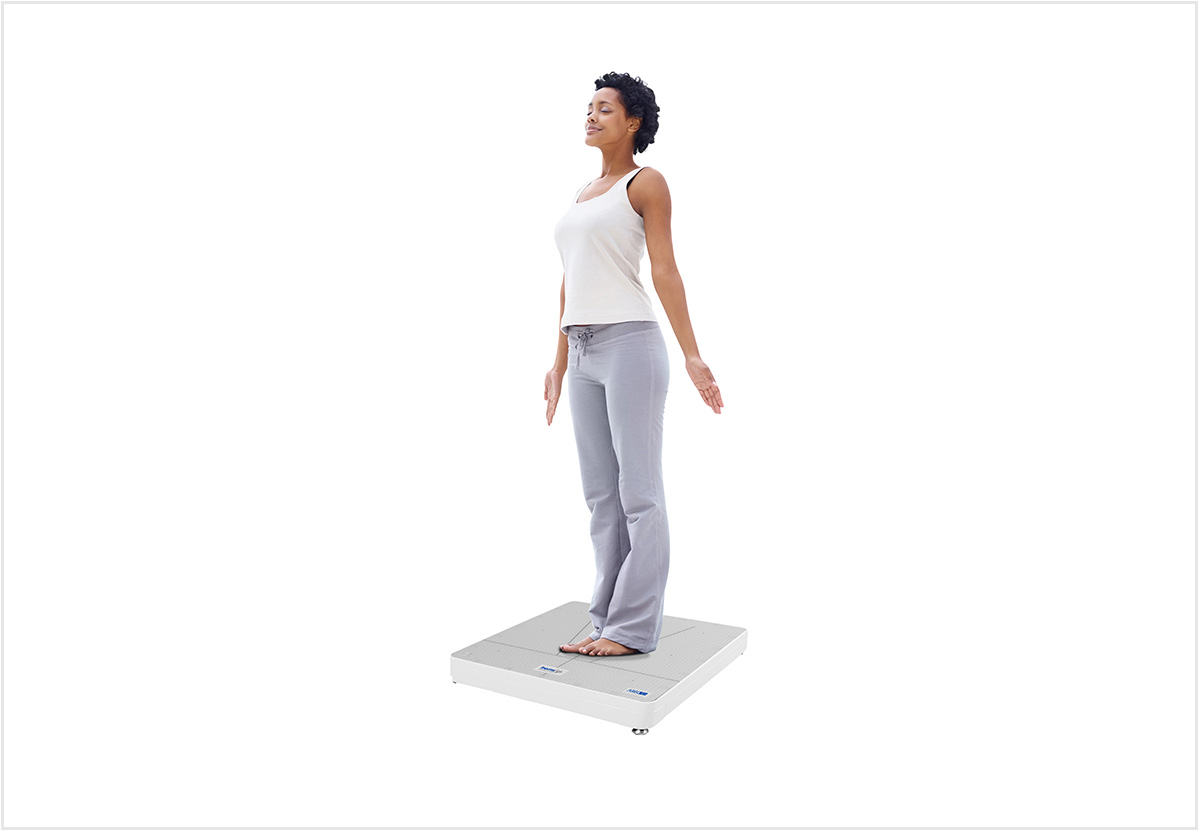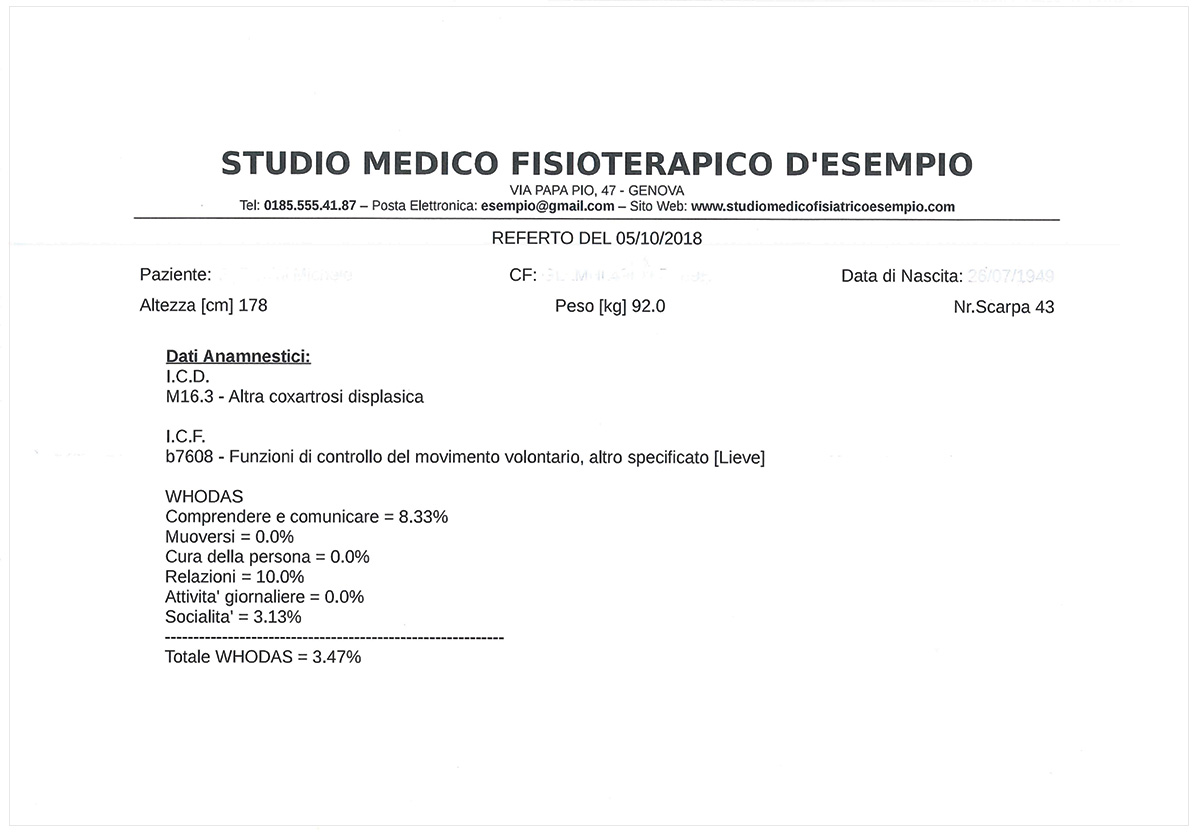
16 Nov Reading the results of the standard stabilometric test
Introduction and purpose of the Romberg test
The purpose of this document is to illustrate the Romberg Test, its execution on the ArgoPlus Stabilometric Platform, the parameters that the instrument provides and the criteria for interpreting them in order to allow the clinician not only to recognize and quantify the possible deficit but also to identify, in the results, the indications for a further diagnostic investigation. In addition to the Romberg test, the device also allows different types of assessment tests in different postures and modes.
The Romberg test¹,²,³ in standardized version, is of particular diagnostic interest (in fact it allows the assessment of the risk of fall and guide in the choices of a possible diagnostic investigation) and therefore it is precisely examined in this document.
The static stabilometric test consists in the detection of the trajectory followed by the COP (point of application of the resulting pressures exerted on the ground through the soles of the feet to counteract the normal torque that would make us fall) while the patient maintains the upright unperturbed stance. The control of the movements of the body segments in the execution of the task involves:
Vision: the two eyes provide ``stabilizing`` indications, especially in the presence of a specific visual reference;
Musculoskeletal proprioception (joints, muscles, tendons and skin): allows comparison between the current and desired positions of body segments for the execution of the motor scheme;
Central Nervous System (CNS) in all its components: it implements the ``individual motor schemes``, in order to execute these patterns in the correct sequence, updating the commands on the basis of proprioceptive and externoceptive return information.
It is important to remember that in the upright unperturbed stance the vestibular contribution is present only in case of anomalies⁴.
In 1836, Professor Romberg proposed a test that, in comparing the oscillations (Sway) measured in the maintenance of the position with closed eyes (where only musculoskeletal proprioception is active) and opened eyes (where visual perception is added to proprioception), allowed the immediate appreciation of the proprioceptive functionality to be associated with central control mechanisms.
With the use of the Static Stabilometric Platform endowed with metrologically validated performances⁵ and employing appropriate processing algorithms, it is now possible to provide an instrumental evaluation of higher sensitivity and accuracy, independent of the operator and therefore repeatable, with a variety of parameters that allow to suggest, in a motivated and objective manner, the possible presence of causes of postural instability.
Test standardization
The essence of the Romberg Test is in the comparison of the results of two measurements, in the exact same conditions, one with closed eyes and the other with opened eyes.
Despite being a controversial topic, in ArgoPlus the standard test is performed⁶ as follows:
with joined and parallel feet (internal malleolus and joints of the big toes in contact);
with arms freely hanging at the sides, head erect, closed mouth with no tightened bite;
positioned on the force platform so that the face of the subject is about 1 m from the wall without any linear reference (it is recommended to apply a round black stamp, with a diameter of 30 mm placed at the height of the nasal saddle of the subject in test);
carrying out the first test with eyes closed and then with eyes open (the order aims to prevent influences through the memory of oculomotor muscles);
the acquisition duration is 40 seconds preceded by 5 seconds of adaptation that are not used in the processing of the parameters.
For the test performed in these conditions there is a robust standard of normality.
Performing the test on ArgoPlus
To perform the ArgoPlus test, follow the procedures below:
a) Register the patient with personal data;
b) Register the test request for the specific patient;
c) Select the patient from the list of sessions to be performed (patients for whom, in the session list, there is no date in the last box on the right);
d) Complete the patient card with the anamnestic data (established pathology according to the ICD coding, functional dysfunction/abnormality accompanied by evaluation of loss of function made by the examining clinician according to the ICF coding, disability evaluation by means of the WHODAS questionnaire; free text space …);
e) Select the CLOSED EYE STANDARD TEST;
f) Check the status of the platform, making sure that the battery is charged and that the platform is leveled (green lights on the top of the screen that will appear selecting – in the upper right corner – FORCE PLATE STATUS);
g) Request that the patient steps on the platform with the correct feet position;
h) Enter the command Start. A new screen containing the following graphs will be shown: statokinesiogram on the left, the stabilogram on the right and below this, at the end of the survey, the frequency analysis;
i) Save the test by asking the patient to retain the position;
j) Select the STANDARD TEST WITH OPEN EYES;
k) Enter the command Start and, at the end, save the test and select EXAM COMPLETED;
l) The patient can step down from the platform.
Reading and interpretation of results
From the REPORT page select the patient who has been tested.
The exam page will appear. By selecting the two tests in sequence, it will be possible to see, under the graphs, also the “page” of the numerical values of the parameters processed.
The same, below mentioned parameters, represent:
- Distance X (Y) of the mean COP point from the Center Base Support [mm]: The distance between the mean of the trajectory and the center of the support base (the intersection of the diagonals that join the vertices of the second toes of the foot with the contralateral calcaneus vertices).
- Sway Path (SP) [mm/sec]: The length of the trajectory followed by the COP normalized to the duration of acquisition and therefore coinciding with the “Mean Velocity” or average speed.
- Sway Area (SA) [mm2/sec]: The swept area by the radius that connects the mean point of the trajectory to all subsequent points in the trajectory, normalized to the duration of acquisition.
- Ratio SA/SP [mm]: It is inversely proportional to the postural “tone”: the tone increases as the value of the ratio falls; it is generally between 2 and 3.
- Oscillations Antero – posterior / Latero – lateral [mm] (Max + Std. Dev.): The statistical distribution of the oscillations provides an indication of the stability more significant than the maximum values of the oscillations. In any case, these are parameters classically considered by the evaluation of the Romberg test. It may be useful to compare the values measured in the two surveys Closed Eyes (CE) vs Opened Eyes (OE).
- Ellipse Area [mm2], Major Axis [mm], Minor Axis [mm], Inclination of Major Axis [degree]. Ratio between the axes [number]: It is the smallest ellipse that contains 95% of the trajectory points. It is another way to evaluate the amplitude of the oscillations.
The two axes allow to verify the presence of a preferential direction of oscillation: if present in the Closed Eyes test, with inclinations on the diagonals, it may suggest the presence of a vestibular problem, while if present in the Opened Eyes test it can suggest the presence of visual deficit (acuity, if the major axis is anterior-posterior, astigmatism, if it is lateral-lateral).- Stay Time (ST) [sec], Spatial Distance (SD) [mm], Time Distance (TD) [sec], Ratio SD/ST [mm/sec]: Sway Density parameters⁷,⁸, recognize and quantify the modalities of control of the equilibrium that is maintained in a sequence of accelerations and decelerations with a time constant around 0.5 sec. From the parameters we can evaluate both the presence of nociceptive interference (ST anomalies in the CE survey) and the motor deficit (SD and SD/ST values). This last ratio, ideally tending to zero, appears to be particularly significant.
- Spectral Power [mm2/Hz]: The harmonic analysis, expressing the Sway in the frequency domain through the discrete Fourier transform⁹ that, transforming the signal from its original form (sample sequence interspersed by 0.01 sec) to the sum of sinusoidal signals of different frequency (integer multiple of the one that has period equal to the time of recording); calculating the amplitudes of each of them allows to identify the presence of coherent oscillations: in other words, oscillations with homogeneous characteristics10.From the single model11 to the triple model12 the human body basically behaves like a pendulum damped by control. The non-damped frequencies (generally better evident in the CE test) are inversely proportional to the height of the irritative focus from which nociceptive signals interfere with proprioceptive signals.
If the non-damped oscillation is on the sagittal plane it can suggest an anomaly on the plane of symmetry, if on the contrary the oscillation is on the frontal plane it can suggest an asymmetric focus.- Score of Postural Functionality [number]: It is a parameter that aims to overcome the poor individual significance of each of the classic parameters 13.Basically it defines the number of indicators, derived from the parameters of the test that are outside the interval ± 2σ around their average value. This model applies to 63 indicators of which normality values are available. Analysing the evidence according to the criteria of the ROC14 methods it has been possible to conclude that this parameter is to be considered a deficit signal when it assumes value ≥ 9.
- LOS AV [%], LOS AD [%], LOS LL [%]: The idea is that, given the height of the subject, Limits of Stability can be defined, or the angular values that bring the projection to the ground of the center of mass outside the base of support. The values of the oscillations (Std. Dev.) are therefore normalized to the limit values for the specific height, expressing them as a percentage of the admissible value15.
On the basis of the above it will be possible to select GENERATE REPORT WITH ROMBERG: the two sets of graphs and a single page of data with the indication of automatically generated annotations (that can be selectively accepted and inserted in the report that will be enriched from a free text) will appear.
VALIDATING the Report will generate the document in .PDF format, automatically accompanied by the name of the referring clinician (complete with any signature in graphic format).
Demonstration exemplification
The attached report provides an example of the above.
On the first page the patient card with the ICD and ICF codes as well as the WHODAS test sum-mary performed on the day of the test are shown.
In this example, the free space in which the patient’s medical history could have been included has not been used.
In the second page the graphs are shown.
In the third page the values of the parameters, which allow to obtain the following observations, are shown:
(1) The oscillations of the Stabilogram of the Closed-Eyes survey show signs of correlation that could suggest central problems
(2) The morphology of the Ellipse of Confidence of the Closed Eyes survey, which is very long on a diagonal, could suggest the presence of vestibular deficits; this explains the signs of centrality exhibited in the Stabilogram
(3) The harmonic analysis of the Closed Eyes survey shows three harmonics of anterior – posterior oscillation at the cervico – thoracic, thoraco – lumbar and lumbosacral hinges, a sign of a postural imbalance that is compensated in the Open Eyes survey. The latero-lateral harmonic is worth mentioning in the sacro-iliac district. The latero-laterality sug-gests to be a disorder outside the symmetry plane that could correlate with a monolateral symptomatology of sciatica.
(4) The ratio between the values of Sway Area and Sway Path of the Opened Eyes survey, in comparison with the Closed Eyes analogue, shows an increase in the postural tone in the Opened Eyes survey, although both are within the limits of norm. The difference (generally the opposite is observed) could be a sign of an insurgent neurological problem
(5) As reported by the asterisk, the subject presents antero-posterior oscillation values of the Closed Eyes survey outside the normal limits.
(6) The “numbers” confirm the assessment of the morphology of the Statokinesiogram of the Closed Eyes survey: the ellipse is excessively long and
(7) The inclination of its major axis appears close to that of the diagonal of the support base
(8) The spectral powers of the low-frequency antero-posterior oscillations of the Closed Eyes survey, as shown by the graph, are outside the range of normality.
(9) The index of postural functionality of the Eyes Closed survey shows that in the test with Closed Eyes, the subject presents an index out of the limit of normality in such a measure as to make it possible to consider an accidental fall that
(10) Could possibly occur backwards. This, in a poorly lit environment.
(11) The proprioceptive deficit, expressed by the quotients of Romberg 18.68 / 11.24 = 1.66 for Sway Path and 43.99 / 16.45 = 2.67 for Sway Area, which being respectively <2 and < 3 are acceptable, does not seem to be of particular concern.
Based on the assessments above, the clinician will be able to draw up a detailed report that is well supported by the evidence.
The “logical” process should follow the following steps:
a) If the values of SPF are both <10, the test is negative.
b) If at least one value of SPF> 9, it is worth investigating further.
c) If the quotients of Romberg are out of the range of normality, a proprioceptive deficit can be hypothesized, viceversa the following conditions must be verified:
c1) the conditions for the possible presence of vestibular deficit (Closed Eyes ellipse with axle ratio >> 1.5 and inclination close to the diagonals)
c2) of visual deficit (Opened Eyes ellipse with axle ratio >> 1.5 and latero-lateral or antero-posterior major axis, respectively for suspected astigmatism or acuity deficiency)
c3) and, in the case of proprioceptive deficit that does not fall into the two cases mentioned above, assuming a musculoskeletal etiology, it is necessary to examine the harmonic analysis to identify the presence and localization of possible focuses that interfere with proprioception.
bibliographic references
¹ Lanska DJ, Goetz CG. Romberg’s sign: development, adoption, and adaptation in the 19th century. Neurology. 2000 Oct 24;55(8):1201-6
² Khasnis A, Gokula RM Romberg’s test. J Postgrad Med 2003;49:169
³ Pearce JM Romberg and his sign. Eur Neurol. 2005;53(4):210-3
⁴ Fitzpatrick R, McCloskey DI. Proprioceptive, visual and vestibular thresholds for the perception of sway during stand-ing in humans. J Physiol. 1994 Jul 1;478 (Pt 1):173-86
⁵ Baratto M., Cervera Ch., Jacono M. Analysis of adequacy of a force platform for stabilometric clinical investigations IMEKO, IEEE, SICE 2nd International Symposium on Measurement, Analysis and Modeling of Human Functions – 1st Med-iterranean Conference on Measurement June 14-16, 2004, Genoa, Italy
⁶ Scoppa F, Capra R, Gallamini M, Shiffer R. Clinical stabilometry standardization: basic definitions–acquisition interval–sampling frequency. Gait Posture. 2013 Feb;37(2):290-2
⁷ Baratto L, Morasso PG, Re C, Spada G. A new look at posturographic analysis in the clinical context: sway-density ver-sus other parameterization techniques. Motor Control. 2002 Jul;6(3):246-70
⁸ Jacono M, Casadio M, Morasso PG, Sanguineti V. The sway-density curve and the underlying postural stabilization pro-cess. Motor Control. 2004 Jul;8(3):292-311
⁹ https://it.wikipedia.org/wiki/Trasformata_discreta_di_Fourier accesso ottobre 2018
10 Demura S, Kitabayashi T, Noda M. Power spectrum characteristics of sway position and velocity of the center of pres-sure during static upright posture for healthy people. Percept Mot Skills. 2008 Feb;106(1):307-16
11 Lakie M, Caplan N, Loram ID (2003) Human balancing of an inverted pendulum with a compliant linkage: neural con-trol by anticipatory intermittent bias. J Physiol 551(Pt 1):357–370
12 Günther M, Wagner H. Dynamics of quiet human stance: computer simulations of a triple inverted pendulum model. Comput Methods Biomech Biomed Engin. 2016;19(8):819-34
13 Gallamini M., Piastra G., Porzio D., Ronchi M., Scoppa F., Bertora F. Instrumental Assessment of Balance Functional Performance. A Numerical Score to Discriminate Defective Subjects: A Retrospective Study J Nov Physiother 2016, 6:5
14 Lasko TA, Bhagwat JG, Zou KH, Ohno-Machado L. The use of receiver operating characteristic curves in biomedical informatics. J Biomed Inform. 2005 Oct;38(5):404-15
15 Juras G,Somka J, Fredyk A, Sobota G, Bacik B. Evaluation of the Limits of Stability (LOS) Balance Test Journal of Human Kinetics volume 19 2008, 39-52




